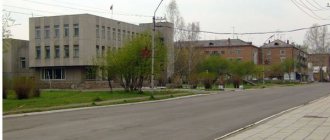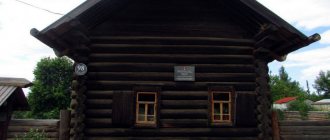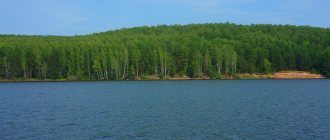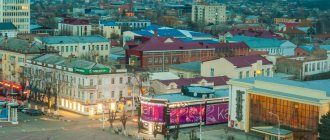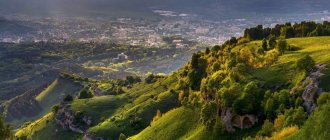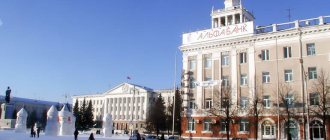Founding of the city of Artemovsk
The founding date of Artemovsk is considered to be 1700. and initially the city bore the name Olkhovka, which it received from its location on the banks of the Olkhovka River; a lot of alder grew in its valley. In 1835, gold deposits were discovered in the vicinity of the village and from that moment Olkhovka began to be considered a mining village in which mines were developed for the extraction of valuable metal. And thanks to this, the town gradually developed. In 1931, the authorities gave it the status of a workers' village with the name Olkhovka. And already in 1939, the village was given the status of a city and a new name - Artemovsk in memory of the famous revolutionary figure Artem.
Artyomovsk
The city of Artyomovsk grew up on the site of the Olkhovka settlement, founded in 1700 and named after the Olkhovka River, in the valley of which alder grew in great abundance. Until the first half of the 19th century, almost nothing was known about the village, but everything changed with the discovery of large reserves of gold in these places. Olkhovskoe gold deposit
In 1852, in the 1st issue of the mining magazine, “Gazette on the activities of the Altai private gold mines” was published, which provided the first information about the amount of gold mined along the Chibizhek River. The statement lists large mines operating along the Chibizhek River: Vladimirsky, Ilyinsky, Spassko-Preobrazhensky, Krestovozdvizhensky and others, where the start of gold mining dates back to 1833.
In 1898, prospectors Roman Tarkhan and Nikolai Belov, while mining a riverbed placer at the mouth of the Srednyaya Tarcha spring, discovered gold deposits; the two largest nuggets found weighed 30.7 and 14.8 kg! A large number of nuggets and placer gold found drew the attention of prospectors from all over the Russian Empire to these places, and the Chibizhek mines began to be quickly populated.
In the summer of 1911, Ural ore miners Vasily Veretennikov, Ivan Mamaev, Pavel Kazantsev and Grigory Usoltsev who arrived here, while examining pits at the top of the Olkhovka spring, dumps of quartz with visible gold were discovered. Further exploration of this area confirmed that the ore located here is rich in gold content. Prospectors organized gold mining by roasting ore, then grinding it in mortars and washing it on trays. The mined ore was transported by horse to the village of Kuzmovka, where it was processed. Veretknnikov’s wife, who received two classes of education, was responsible for accepting gold and accounting for work; she was the only literate person in the artel.
In 1913, the famous gold miner K.I. Ivanitsky, through pressure and blackmail, forced the prospectors to sell him the Olkhovsky gold-bearing area for very little money. Moreover, he paid part of the amount immediately, and paid the rest in small installments until the October Revolution. In the first year, 17.5 pounds of gold were mined, and in the following years, gold production was increased to 30 pounds per year. In 1914, Konstantin Ivanitsky founded the Olkhovsky Gold Mines joint-stock company, the fixed capital of which was 2 million rubles. The goal of the society was to develop the Olkhovsky gold mines on the territory of the Minusinsk district of the Yenisei province. Ivanitsky owned 15 thousand shares out of 20 thousand. To extract gold ore, construction began on a gold-extracting running factory and a plant for extracting gold from ore by chemical means. The joint stock company began operating in July 1915.
Olkhovka before the revolution
The construction of workers' settlements began - Verkhny Stan (at the top of the Olkhovka spring, ore was directly mined here) and Nizhny Stan (3 versts away from Verkhny Stan, ore was processed here). The mined ore was transported to the running mill by private ore carriers on horses.
Before the revolution, the mine was a private handicraft enterprise, where work was based, as in the entire gold industry, on the harsh exploitation of workers. Mine workers worked 12 hours a day. Each shift was assigned a “lesson” and the workers could not go home without completing it. The lessons were such that many workers rarely completed the allotted time.
Single and family workers lived together, located in common barracks and barracks. The Tatars and Chinese, who numbered about a hundred people, occupied separate barracks. The kitchens in the barracks were shared; here they not only prepared food, but also dried work clothes. A paramedic and a teacher worked at the mine, there was a bathhouse and a grocery store that sold goods according to collection books. The money earned was paid at the end of the season, so the workers were forced to purchase stale goods, because... In other places nothing was released without money. During calculations, conflicts often arose between the mine manager and the workers, because the seller often wrote down in the pick-up books of illiterate workers those goods that they did not take. At the same time, the truth was rarely sought - the police officer and the manager were the only authorities.
The Olkhovsky mine lay in the remote taiga, far from the Siberian highway, as well as from the nearest villages and cities of Krasnoyarsk and Minusinsk. Geologist Ya. S. Edelshtein, who visited the mine in 1915, left a description of the routes to it: “From Minusinsk to the village of Pokrovskoye on Kizir, 120 miles can be traveled by tarantass in one day. The fare is 11–12 rubles. From Pokrovsky to Folding Place you can drive along Kizir on poles - 70 versts. On the way, you can have an overnight stay and get provisions in the large taiga village of Cordovo. From the folding place to Olkhovka there is a path along which you can ride a horse. The path, for the most part, runs among dense tall trees, where darkness reigns even at midday...”
.
After the revolution
The revolutionary events of 1917 did not reach the Olkhovsky mine, and political exiles were not sent here either. There was no one here to organize workers’ protests, and individual small protests were spontaneous and unorganized and were promptly suppressed by the local administration. Therefore, after the revolution at the mine, the workers did not feel any visible social changes. And only during the Civil War, in 1919, a small detachment arrived here and proclaimed Soviet power here. The gold at the mine was seized and sent to the Minusinsk Bank, the owners fled. The organized labor committee petitioned the bank, which issued money to pay the workers.
The miner Fyodor Volkov, who had two classes of education and authority among the workers, was elected as the first manager of the mine from the Soviet government. He was replaced by Fedosy Nikolenko, who played a large role in organizing gold mining in the difficult post-revolutionary years.
In the first years of Soviet power, no significant changes were observed at the Olkhovsky mine; restoration work was carried out here. Production corresponded to the level of 1916. At the All-Russian Gold Mining Congress in 1926, the need for systematic searches and exploration of new gold deposits was recognized; in this regard, in 1927, the All-Union Joint Stock Company "Soyuzzoloto" was created, the founders of which were gold mining enterprises, from now on united into a single structure. From this moment on, a new stage in the development of the rich Olkhovskoye deposit began.
Already in 1927, an aerial cableway was installed, along which ore was transported from the mining site to the flotation plant. And in 1929, the Jeb power station was put into operation. In 1930, a highway was built that connected the taiga Olkhovka with the rest of the world. The villages of Nizhny Stan and Verkhny Stan were united into a single large village, which on January 23, 1931 was given the status of a workers' village and the name Olkhovka.
In 1934, a new enrichment plant was put into operation. At the same time, the mining workshop was reconstructed, shaft No. 2 was deepened, and a compressor station was built. In the mid-1930s. The construction of the housing stock proceeded at a rapid pace; a cultural center, shops, a school, a hospital, a clinic, a stadium, and a bathhouse were built and began to function. Following the expansion of production and social infrastructure, an influx of workers to the mine began.
Artyomovsk has city status
In 1936, at the request of the workers, the Olkhovsky mine was renamed the Artyom mine - in honor of the revolutionary Fyodor Andreevich Sergeev, better known as “Comrade Artyom”. In 1939, the village of Olkhovka was renamed the city of Artyomovsk. Gold mining by this time had increased 10 times compared to pre-revolutionary 1916.
In the pre-war years, the young taiga gold mining town of Artyomovsk developed rapidly, and the city was in full swing with sports and cultural life. Various clubs, artistic and technical, are beginning to open at the local cultural center. Football teams are created in the workshops, as well as teams in other sports. There was even an aviation club organized.
The mine became the basis for the formation of the Minusinskzoloto plant, which included 16 mine departments that developed placer deposits in the south of the Krasnoyarsk Territory. During these years, a factory training school (FZO) was opened in Artyomovsk, which began to train qualified personnel required by the enterprises of the plant.
The management of the plant paid great attention to the development of sports. A U-2 sports plane (biplane) was purchased. The first pilot was A. Kolosov, a resident of Artyomovsk, who later became a flight instructor. Before the war, the city stadium hosted football championships, in which teams from all gold mining enterprises of the Far East and Siberia took part; the Artyomovsky stadium was the best among the stadiums of similar enterprises. Many key specialists, including the chief engineer, played as part of the combined team of the plant.
During the Great Patriotic War, the level of metal production was maintained at the 1940 level. Mostly women and old people worked at the mine as workers, replacing men who had gone to the front. Many women even worked in tunneling and clearing work.
In 1951, the Minusinskzoloto plant was liquidated, and the Artyomovsky mine became its legal successor. Due to the liquidation of old mines, gold mining volumes in the 1950s. began to decline noticeably, there is a need to intensify geological exploration work. A permanently based Artyomovsk hydraulic fracturing unit is being created at the mine. Exploration of the Distlerovskoye, Verkhnee-Torchinskoye and Konstantinovskoye deposits was carried out; the Sayanskoye and Chibizhekskoye geological exploration enterprises of the Krasnoyarsk Geological Department were engaged in them for a long time. Much work was carried out by scientists from the Tomsk Polytechnic Institute, various geophysical and geochemical teams, and the geological department of the mine. As a result of these surveys, a new one was discovered in 1957, 1.5 km from the Olkhovskoye deposit, called Medvezhye. Its exploitation continued until 1979, when its reserves were completely depleted and mining operations were stopped.
In 1960, geologists from the Sayan hydraulic fracturing group discovered the Lysogorskoye deposit, and several years after exploration work, mining began there. In addition, geologists conducted exploration of placer gold deposits. For example, in 1968, a 250-liter dredge No. 125 was installed on the site of an explored placer near the Balyk-su River.
After a long break in the development of placer deposits, prospecting cooperatives in the late 1970s. metal mining was resumed along the Balakhtison, Tarbatka, Kuvay and Chibizhek rivers. During the same period, the mine's production assets, housing and social amenities were partially updated. The Artyomovskaya enrichment plant was reconstructed, the vehicle fleet was updated, and a garage for 25 cars was built.
As a result of government reforms in the 1990s, which negatively affected the entire economy of the country, gold mining was sharply reduced and the construction of industrial, social and housing facilities was frozen. The sanatorium, pioneer camp and other social and cultural facilities are closed. Since January 1996, gold production at the mine has actually ceased; the enterprise is mired in debt and faces bankruptcy, despite the fact that the mine has industrial reserves of gold.
Territorial features of Artemovsk
Artemovsk is located 380 km from Krasnoyarsk. 12 km from the city there is the Koshurnikovo railway station on the Abakan – Taishet line. The railway does not pass through the city territory. Artemovsk also includes the village of Dzheb. The Olkhovka River flows through the city, dividing it into several parts. The main street of Artemovsk is called Olkhovskaya and is located on the right bank of the river. The city is engaged in the timber industry, gold, copper and silver mining. The largest enterprise in Artemovsk today is Yeniseizoloto. It is engaged in the development of deposits of valuable metals in the vicinity of the city. But nevertheless, the city's economy is in decline. Most mines are closing, losing profitability. High percentage of unemployment, population decline due to labor migration.
History of Artemovsky
It is believed that Artemovsky was founded on the right bank of the Bobrovka River (a tributary of the Irbit River) in 1665 by Egorsha Kozhevin, a native of the Aramashevskaya settlement. In honor of him, the place began to be called “Egorshin Povytok”, then “Egorshina Village”, and since 1864 - the village of Egorshino.
Model of the monument to Yegorsha Kozhevin in the Artemovsk Museum
In 1871, a rich deposit of anthracite coal was discovered nearby. It all started with Vasily Skutin’s discovery of coal in his garden. The discovery gave impetus to the development of the settlement. If coal had not been discovered, Yegorshino would probably have been an ordinary village. In 1872, the industrial development of coal began and mines appeared. In 1913, the largest mine in the Sofia basin was opened.
Together with this mine E.P. Demidov began construction of the Yegorshinskaya power plant on the Bobrovka River. However, due to the outbreak of war, construction was suspended. After the fall of tsarism and the end of the civil war in 1920, the construction of the Yegorshinskaya State District Power Plant was recognized as an impact project of GOELRO. And so, on October 28, 1923, the power plant produced its first current.
In 1914, the first stage of the railway to Yekaterinburg was commissioned.
In 1921, the Bobrovskaya coal mine was named the Artyom Mine - in honor of the revolutionary F.A. Sergeev, known as Comrade Artem. In 1925, due to the merger of mining villages, the village of Artemovsky was formed, which in 1938 merged with the village of Egorshino, and the city of Artemovsky was formed. In 1960 it became a city of regional subordination.
Coal continued to be mined here throughout the Soviet period. In 1929, the largest mine in the basin, “New Rudnik,” was put into operation.
In 1930, the Yegorshinsky radio center opened, thanks to which the Yegorshinsky Radio Plant later appeared. During Soviet times, the radios and radio stations of this plant were known throughout the country. During the war years, in 1941, the Skopinsky Mechanical Plant was evacuated to Artemovsky, which gave rise to the Artemovsky Machine-Building Plant.
Alexander Misharin, a railway worker and one of the governors of the Sverdlovsk region, grew up in Artemovsky, however, he did not distinguish himself in anything good in this post.
In this city lived the Ural “left-hander” - Alexander Matveevich Sysolyatin (1927-1981), a famous master of microminiatures. The works of this craftsman are known not only in Russia, but also in other countries of the world.
According to the 2010 census, 33,160 people live in Artemovsky. Due to economic problems, the city's population is declining. Currently, all coal mines in the area are closed.
Sights of Artemovsk
There are no attractions within the city limits. There are no museums, monuments, or theaters. Outside the city limits you can admire the beautiful nature. Other attractions include Lake Khudozhnikov, which is located near the outskirts of Artemovsk in the territory of the Ergaki natural park. The lake was discovered by a group of artists from Krasnoyar in the mid-twentieth century. Near the lake there are two rocks that look like a parabola. In summer, many tourists and artists relax here.
